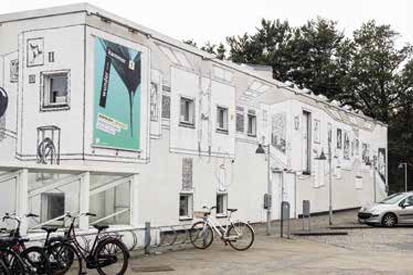Esbjerg Art Museum

An aesthetic experience to rouse your Playfully respectful buildings curiosity
TEXT:NICOLAI LISBERG | PHOTO © TORBEN E. MEYER
At Esbjerg Art Museum, the focus is on raising questions rather than on providing answers – especially in the current exhibition, Wunderkammer, which is dedicated to an investigation of how art may be reconnected with the realm of everyday experiences.
“Often times, art is exhibited as something unrelated to life itself. We, however, think of art as related to our very existence and everyday life!” Christiane Finsen is a curator at Esbjerg Art Museum, which has a long tradition of inserting art into a greater context. There, they often mix art with other knowledge areas, such as music and physics, in order to create an aesthetic experience for their guests.
“We like to think that it’s all connected, and we want to re-establish a connection between art and the rest of the world. We want people to leave the museum with a new approach to experiencing new phenomena, to see the world in a different way. That, for us, is an aesthetic experience,” says Finsen.
A place to wonder
The current exhibition at Esbjerg Art Museum is called Wunderkammer. It is an ambitious exhibition that was made possible thanks to the Bikuben Foundation’s Vision Prize, which rewards a particularly visionary idea. “The concept of a ‘wunderkammer’, loosely translated as ‘a chamber of wonder’, dates back to the Renaissance and is the forerunner of what we know as museums today. We came up with the concept because we want people to wonder, and we want to rouse their curiosity,” says Finsen.
The project is divided into three parts, and the first part is arranged in cooperation with physics professor Tomas Bohr, grandchild of the famous Niels Bohr. It focuses on fluid dynamics and thus on everyday phenomena like a drop of water hitting a surface, or liquid being stirred in a pot. Bohr and his team have chosen to recreate and present five interactive experiments that everyone can relate to, according to Finsen. “For example, it is possible to follow Bohr’s liquid-drop dynamics in a laboratory set-up juxtaposed with works of art. We all think we know what a water drop looks like, but it turns out to be something completely different. You can try the experiment, create your own drop, and see it projected onto the wall where it interacts with the surrounding artworks. It’s just one example of how we aim to generate new encounters and a new space, in which established and traditional categories and divides between art and natural science, sensing and thinking, subjective experiences and scientific objectivity, may be decomposed and allowed to cross-fertilise each other.”
Subscribe to Our Newsletter
Receive our monthly newsletter by email





